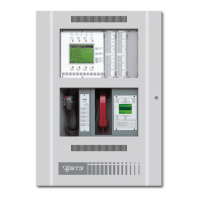System calculations
EST3 Installation and Service Manual B.3
Cable properties
Data and audio networks in an EST3 system do not require the
use of shielded cable, and networks designed with twisted-pair
can be about twice as long as those designed with shielded cable.
The maximum length of a data network varies with the
properties of the wire used. Wire manufacturers typically
provide specifications for wire resistance and capacitance.
Resistance is generally specified in ohms per 1,000 feet, and
must be doubled for 1,000 feet of a twisted-pair cable.
Capacitance is specified in picofarads per foot (pF/ft).
The capacitance between conductors of a twisted-pair is
commonly referred too as conductor-conductor or mutual
capacitance. Shielded cable has an additional capacitance
between each conductor and the shield. The capacitance of either
conductor to shield is typically twice the value of mutual
capacitance, and the highest value of capacitance must be used
when calculating the maximum length of a data network.
The overall length of data networks designed with twisted-pair
cable is about twice as long as data networks designed with
shielded cable due to the additional capacitance resulting from
the shield.
Calculating a maximum length
The maximum length of a data network can be calculated by
dividing the maximum cumulative capacitance allowed by the
highest capacitance rating of the selected cable.
For example, say you wanted to determine maximum length of a
data network using 18 AWG cable that is rated at 25 pF per foot.
The network will communicate at 38.4 Kbaud.
The maximum length equals the maximum cumulative
capacitance divided by the capacitance per foot. In equation
form:
ML = MCC / CPF
Where:
ML = Maximum length
MCC = Maximum cumulative capacitance
CPF = Capacitance per foot
In our example:
ML = 1.4 μF / 25 pF/ft
ML = 56,000 ft

